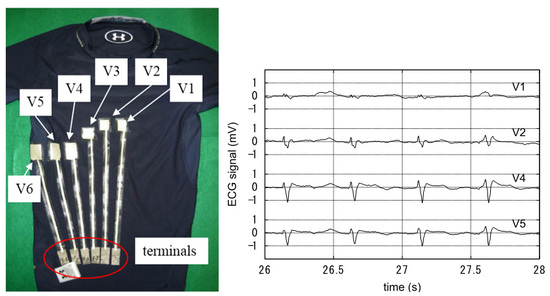A Smart Shirt Made with Conductive Ink and Conductive Foam for the Measurement of Electrocardiogram Signals with Unipolar Precordial Leads
Abstract
:1. Introduction
2. Experimental Materials and Methods
2.1. Manufacturing of the Smart Shirt


2.2. Manufacturing of a Conductive Foam Block
2.3. Measuring the Contact Pressure at Each Electrode
2.4. Measuring the ECG
3. Results and Discussion
3.1. Manufactured Smart Shirt

3.2. Manufactured Conductive Foam Block




3.3. Measured Contact Pressure at Each Electrode
| Electrode | V1 | V2 | V3 | V4 | V5 | V6 |
|---|---|---|---|---|---|---|
| without conductive foam blocks (kPa) | 0.0 | 0.0 | 2.7 | 2.4 | 1.8 | 2.0 |
| with conductive foam blocks (kPa) | 3.7 | 3.5 | 4.5 | 4.9 | 3.5 | 3.3 |

3.4. Measured ECG Signals





4. Conclusions
Acknowledgments
Author Contributions
Conflicts of Interest
References
- Paradiso, R.; Rossi, D.D. Advances in textile technologies for unobtrusive monitoring of vital parameters and movements. In Proceedings of the 28th IEEE EMBS Annual International Conference, New York City, NY, USA, 30 August–3 September 2006; pp. 392–395.
- Karlsson, J.S.; Wiklund, U.; Berglin, L.; Östlund, N.; Karlsson, M.; Bäcklund, T.; Lindecranz, K.; Sandsjö, L. Wireless Monitoring of Heart Rate and Electromyographic Signals Using a Smart T-shirt. In Proceedings of the 5th International Workshop on Wearable Micro, and Nano Technologies for Personalised Health, pHealth, Valencia, Spain, 21–23 May 2008.
- Vojtech, L.; Bortel, R.; Neruda, M.; Kozak, M. Wearable Textile Electrodes for ECG Measurement. Adv. Elect. Electr. Eng. 2013, 11, 410–414. [Google Scholar] [CrossRef]
- Tada, Y.; Inoue, M.; Tokumaru, T. An evaluation of the characteristics of a stretchable ink wire suitable for the measurement of biological signals. J. Text. Inst. 2014, 105, 692–700. [Google Scholar] [CrossRef]
- Tsukada, S.; Kasai, N.; Kawano, R.; Takagahara, K.; Fujii, K.; Sumitomo, K. Electrocardiogram Monitoring Simply by Wearing a Shirt—For Medical, Healthcare, Sports, and Entertainment. NTT Tech. Rev. 2014, 12, 1–7. [Google Scholar]
- Lage, J.; Catarino, A.; Carvalho, H.; Rocha, A. Smart Shirt with Embedded Vital Sign and Moisture Sensing. In Proceedings of The First International Conference on Smart Portable, Wearable, Implantable and Disability-oriented Devices, Brussels, Belgium, 21–26 June 2015; pp. 25–30.
- Carvalho, H.; Catarino, A.P.; Rocha, A.; Postolache, O. Health monitoring using textile sensors and electrodes: An overview and integration of technologies. In Proceedings of the 2014 IEEE International Symposium on Medical Measurements and Applications (MeMeA), Lisbon, Portugal, 11–12 June 2014; pp. 1–6.
- Morrison, T.; Silver, J.; Otis, B. A Single-chip Encrypted Wireless 12-Lead ECG Smart Shirt for Continuous Health Monitoring. In Proceedings of the 2014 Symposium on VLSI Circuits Digest of Technical Papers, Honolulu, HI, USA, 10–13 June 2014; pp. 1–2.
- Reuters: ECG Shirt Warns Wearer of Heart Problems via Smartphone. Available online: http://www.personal-healthwatch.com/reuters-ECG-shirt.aspx (accessed on 25 August 2015).
- Marozas, V.; Petrenas, A.; Daukantas, S.; Lukosevicius, A. A comparison of conductive textile-based and silver/silver chloride gel electrodes in exercise electrocardiogram recordings. J. Electrocardiol. 2011, 44, 189–194. [Google Scholar] [CrossRef] [PubMed]
- Paul, G.; Torah, R.; Beedy, S.; Tudor, J. The development of screen printed conductive networks on textilesfor biopotential monitoring applications. Sens. Actuator A 2014, 206, 35–41. [Google Scholar] [CrossRef]
- Seoane, F.; Mohino-Herranz, I.; Ferreira, J.; Alvarez, L.; Buendia, R.; Ayllón, D.; Llerena, C.; Gil-Pita, R. Wearable Biomedical Measurement Systems for Assessment of Mental Stress of Combatants in Real Time. Sensors 2014, 14, 7120–7141. [Google Scholar] [CrossRef] [PubMed]
- Lobodzinski, S.S.; Laks, M.M. Comfortable textile-based electrocardiogram systems for very long-term monitoring. Cardiol. J. 2008, 15, 477–480. [Google Scholar] [PubMed]
- Sardini, E.; Serpelloni, M. Instrumented Wearable Belt for Wireless Health Monitoring. In Proceedings of the Eurosensors XXIV, Linz, Austria, 5–8 September 2010; pp. 580–583.
- Sardini, E.; Serpelloni, M.; Ometto, M. Multi-parameters wireless shirt for physiological monitoring. In Proceedings of the 2011 IEEE International Workshop on Medical Measurements and Applications, Bari, Italy, 30–31 May 2011; pp. 316–321.
- Trindade, I.G.; Martins, F.; Miguel, R.; Silva, M.S. Design and Integration of Wearable Devices in Textiles. Sens. Transducers 2014, 183, 42–47. [Google Scholar]
- Wagner, G.S.; Strauss, D.G. Marriott’s Practical Electrocardiography, 12th ed.; Lippincott Williams & Wilkins: Philadelphia, PA, USA, 2013; pp. 28–30. [Google Scholar]
- Inoue, M.; Itabashi, Y.; Tada, Y. Development of Bimodal Electrically Conductive Pastes with Ag Micro- and Nano-fillers for Printing Stretchable E-textile Systems. In Proceedings of the 20th European Microelectronics and Packaging Conference & Exhibition, Friedrichshafen, Germany, 14–16 September 2015.
- Inoue, M.; Hayashi, Y.; Takizawa, H.; Suganuma, K. Formation mechanism of nanostructured Ag films from Ag2O particles using a sonoprocess. Colloid Polym. Sci. 2010, 288, 1061–1069. [Google Scholar] [CrossRef]
© 2015 by the authors; licensee MDPI, Basel, Switzerland. This article is an open access article distributed under the terms and conditions of the Creative Commons Attribution license (http://creativecommons.org/licenses/by/4.0/).
Share and Cite
Tada, Y.; Amano, Y.; Sato, T.; Saito, S.; Inoue, M. A Smart Shirt Made with Conductive Ink and Conductive Foam for the Measurement of Electrocardiogram Signals with Unipolar Precordial Leads. Fibers 2015, 3, 463-477. https://doi.org/10.3390/fib3040463
Tada Y, Amano Y, Sato T, Saito S, Inoue M. A Smart Shirt Made with Conductive Ink and Conductive Foam for the Measurement of Electrocardiogram Signals with Unipolar Precordial Leads. Fibers. 2015; 3(4):463-477. https://doi.org/10.3390/fib3040463
Chicago/Turabian StyleTada, Yasunori, Yusaku Amano, Tomonobu Sato, Shigeru Saito, and Masahiro Inoue. 2015. "A Smart Shirt Made with Conductive Ink and Conductive Foam for the Measurement of Electrocardiogram Signals with Unipolar Precordial Leads" Fibers 3, no. 4: 463-477. https://doi.org/10.3390/fib3040463
APA StyleTada, Y., Amano, Y., Sato, T., Saito, S., & Inoue, M. (2015). A Smart Shirt Made with Conductive Ink and Conductive Foam for the Measurement of Electrocardiogram Signals with Unipolar Precordial Leads. Fibers, 3(4), 463-477. https://doi.org/10.3390/fib3040463






